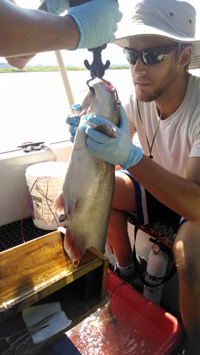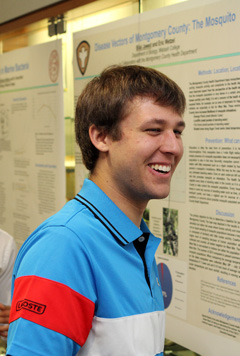Click here for a full Celebration schedule
There will be plenty of great things on display Friday at the 15th annual Celebration of Student Research, Scholarship, and Creative Work. There is little doubt that it is the finest student-centered day on the Wabash calendar.
This story takes a works-in-progress look at two students – Travis Flock ’16 and Ryan Horner ’15 – and their efforts to prepare works for the Celebration. How their vastly different projects took shape, withstood the editorial process, and became polished enough to present to peers and colleagues.
On the surface, their approaches couldn’t have been more different. Flock, a biology major, spent the better part of the last eight months working on the research for his presentation, “Tracking Blue Catfish Movement in Chesapeake Bay Using Acoustic Telemetry,” while Horner, an English major, got the first glimmer of the idea for his short story, ”It Came Under Some Duress,” roughly six weeks ago.
Despite different timelines, both students had strong feelings about the benefits of the event itself. The fact that Wabash engages, supports, and encourages students to participate as academic equals is witnessed in the participation of more than 100 students making 104 poster or oral presentations.
“As someone who hopes to spend my life in academia,” Horner said, “I think the Celebration of Student Research highlights one of the best things about Wabash: students conducting original research and producing original work, and then showcasing that work in front of a diverse community who cares to see how they've grown.”
__
With spring final exams in his rearview mirror, Flock’s travels to the Smithsonian Environmental Research Center (SERC) for an internship on the Chesapeake Bay in Maryland served as a fitting metaphor in itself. He had never been to Chesapeake, and SERC is a 2,700-acre oasis within urban sprawl less than an hour east of Washington, D.C.
 “It was exciting to see the different terrain,” Flock recalled. “SERC was desolate by comparison to Washington, D.C., and Annapolis. I thought that was so cool.”
“It was exciting to see the different terrain,” Flock recalled. “SERC was desolate by comparison to Washington, D.C., and Annapolis. I thought that was so cool.”
The Mooresville, IN, native had next to no experience in the field and joined a team where everyone else seemed to have a Ph.D. or was pursuing one.
It was out of the car and into the marsh for Flock. From installing fish weirs – obstructions placed in the water to guide fish to particular locations – to retrieving radio receivers six feet under water and surveys of the Pawtuxet River, the adjustment to life in the field was baptism by fire: 100-pound equipment deadlifts in the marsh, nine-hour shifts on the boat tracking down data, or catching and tagging blue catfish. It was nothing like dealing with lab components. And Flock found all of it to his liking.
“Physically, it was very demanding,” he said, “but I liked being outside and the time seemed to move so much quicker in the field. It was good for me because that’s what I wanted to do. I wanted to get in the water and have an experience that I wouldn’t get here in Indiana.”
The focus of Flock’s research was the blue catfish (Ictalurus furcatus), an invasive species to the Chesapeake watershed. Working directly with primary investigator Dr. Matthew Ogburn, Flock helped to catch and implant these fish with small acoustic tags for tracking on a series of acoustic receivers throughout the Chesapeake Bay basin. The goal was to get a handle on the movement patterns of this fish so that the data found could help with management strategies down the line.
__
It seems as though thoughts are always bouncing around in Horner’s head, but perhaps that’s because he runs a lot. A distance runner for the Wabash cross country and track squads, Horner uses his time running – an hour a day, six days per week over the semester break – as a filter for what sticks. Because those thoughts that linger in the mind have a greater chance of ending up on the page.
Borrowing a term from author Pam Houston, Horner called those thoughts “glimmers.” It’s those glimmers that eventually evade the editor’s cut and see the light of day.
“Whatever sticks in your head might become an idea or line in the story,” said Horner, a product of Greentown, IN. “Part of the writing process is figuring out why that image or phrase or way of thinking sticks with me. They are the ones that get turned over enough in free writing or in reflective thinking. The ones that have stuck with me the longest are the ones that survive rewriting and editing because I’m not willing to cut them.”
image or phrase or way of thinking sticks with me. They are the ones that get turned over enough in free writing or in reflective thinking. The ones that have stuck with me the longest are the ones that survive rewriting and editing because I’m not willing to cut them.”
He’s gotten more serious about his writing in the last year. Like running, Horner says he writes five or six days a week for as much as two hours at a time, which is double what he used to do. The more he can write, the more quickly his pieces develop. Like any endeavor, if you want to improve, you have to put in the time.
Horner has been an English literature major for two years now, so his usual writing routine is also a work in progress. It varies with each new project. Goal number one is getting the reader into the story, and that can occur through free writing, observations, or a random thought.
“First thing for me is to find a lens into the story,” said Horner, who is also working on applications to 13 graduate schools. “There has to be a starting point.”
__
The work continues. After eight months, countless hours on a boat, working closely with a P.I., and even more analyzing data, the work flows right into Friday. Over the semester break, Flock had designs on expanding sections across the board, including his introduction and methods, and adding all six of the graphs from his results, including the stat tests to his poster.
 “I want to have the presentation to the standards that Dr. Ogburn, SERC, and Wabash suggested,” said Flock. “I hope it will connect with people more strongly, in terms of understanding the nature of the problem, and allow for interpretations and questions. The more people I can share this information with efficiently, the more people we are educating about our work.”
“I want to have the presentation to the standards that Dr. Ogburn, SERC, and Wabash suggested,” said Flock. “I hope it will connect with people more strongly, in terms of understanding the nature of the problem, and allow for interpretations and questions. The more people I can share this information with efficiently, the more people we are educating about our work.”
The presentation, which happens in Friday’s first poster session at 1 p.m., could be the most daunting part of the process. Flock has never formally presented his research before. In fact, he says that simply saying “my research” doesn’t feel quite right. However, he appreciates the stage that the Celebration represents.
“Presenting it to the scientific community – people with master’s degrees and Ph.D.s who have accomplished more than me – is a different scale than what you might do in the classroom. It’s solely yours and you are trying to make a public impact about what you’ve done. I so much enjoyed this entire process. It was easily the best job-related experience of my life. After everything, it’s a strong validation of what I want to go into and why I want to do it.”
__
No less than 48 hours from the Celebration, Horner is zeroing in on a conclusion, though it’s not finished yet. He thinks he’ll probably tinker with the piece until his reading in Detchon 111 at 2:40 p.m. There was a comfort in his voice as he said, “I have a final resolution for the story, though that hasn't made it on the page yet. At the end, the characters kind of fall apart, but also kind of come together. We don't see them solve the problem; we see them recognize the problem, and then we just barely see them start the problem-solving process.”
Horner is also excited about reading this piece publicly, which has him looking forward to Friday.
“Since I’ve never read fiction at the Celebration, I’m really excited to see how the people in the room react to the piece,” he said. “That will tell me a lot about what I’ve written than any of my own thinking. The Celebration will be the first audience-based revision that I’ve done.”
This exercise has also been good for Horner on two fronts. First, it’s given him purpose to write creatively over the last month, when he might not have done so under different circumstances – “it’s been a curveball,” he says. Secondly, he’s discovered that this piece might be the foundation of something that gets submitted to a journal down the road.
be the foundation of something that gets submitted to a journal down the road.
“I’m thankful that I’ve been diligently working on this piece,” he said. “It’s nice to know that this is just a step in the process. Whatever is read (Friday) will not be the final product. The piece read and the piece potentially submitted to a journal could be quite a bit different. It’s a trial by fire, and I’ve enjoyed this process.”